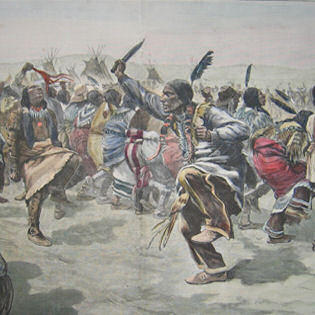 The Native American tribes of the Northern Plains, forced onto reservations and near starving in 1890, were drawn in large numbers to a new religion called the Ghost Dance. Led by the shaman Wovoka, this mystical cult sought through ritual dancing to bring about a magical restoration of the world that they once had known. If they performed the dance with a pure heart, Wovoka assured them, it would bring their ancestors’ ghosts back to life and bring the great herds of buffalo back to the plains.
The Native American tribes of the Northern Plains, forced onto reservations and near starving in 1890, were drawn in large numbers to a new religion called the Ghost Dance. Led by the shaman Wovoka, this mystical cult sought through ritual dancing to bring about a magical restoration of the world that they once had known. If they performed the dance with a pure heart, Wovoka assured them, it would bring their ancestors’ ghosts back to life and bring the great herds of buffalo back to the plains.
The Ghost Dance soon lost its popularity with the tribes when no restoration happened. The buffalo remained on the verge of extinction for many years, and the families on the reservations continued to live in poverty. The tribes lost much of their history and culture when large numbers of children were taken away to boarding schools to learn English and to become assimilated into an America where their skin color would always mark them as second-class citizens.
Now, over a century later, the world we live in bears little resemblance to the one that the Ghost Dance believers sought to restore. Buffalo herds are no longer a rare sight, thanks to bison conservation efforts and commercial ranching, but they no longer have the cultural significance that they had when the tribes relied on hunting for survival. And while a modern lifestyle of burgers and fries, pickup trucks, paychecks and mortgages does indeed have some advantages in that most people nowadays don’t have to hunt anything to put food on the table, it also has its constraints. In today’s world, we almost never look out over wide-open landscapes, breathe in the magic of a new day and feel confident that the Earth will provide for our needs. We just stop at the local burger joint for a take-out meal.
Sometimes I feel like a ghost blogger, sending forth my words to dance on glowing screens in the hope of restoring a world that has been altered irrevocably. When I write about autistic people and our way of life, I have in mind a social minority culture that existed long before today’s labels and diagnostic categories. This culture, the one in which I grew up, strongly encouraged a love of learning and of the natural world. Passionate interests were often discussed at length, not stigmatized as symptoms of an unfortunate disorder. Like the tribespeople when the buffalo still roamed the plains, we felt an almost mystical confidence that there would be a place for us in the world.
This is not, however, the existence that many of our young people know. Like the conquered tribes struggling to survive on the reservations, their natural way of life has been taken from them, forcibly suppressed and branded inferior. Many autistic students attend segregated schools where, like the Native American children in the boarding schools, they are taught that they must change almost everything about themselves before the majority population will grudgingly tolerate their presence.
At some point in the future, mainstream society’s greater awareness of autistic differences can be expected to have more positive outcomes. Schools and workplaces will adapt to accommodate our needs. As with other minority groups, our diversity will be accepted and our contributions to society valued. Our right to self-determination will be protected. Our culture and way of life will be recognized as legitimate.
And yet, when this happens, we will no longer be the same people.
Crossposted from Whose Planet Is It Anyway?
Guest on 01/25/10 in featured, Society | No Comments | Read More

